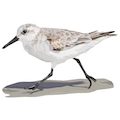Abstract
Sanderlings Calidris alba nest in the high Arctic and migrate to winter in coastal areas at a wide range of latitudes where they are regularly counted as part of the International Waterbird Census (IWC). However, given their broad range of habitats (which includes beaches and small lagoons, for example), counting Sanderlings in the large wetlands typically targeted by the IWC may provide an incomplete assessment of their population. To better survey the Sanderling wintering population in Portugal, we monitored the coast of Portugal with Projeto Arenaria, a citizen science project that counts Sanderlings and other waders on open rocky and sandy shores, since the winter of 2009–2010. Further, in the winters of 2015–2016 and 2021–2022, we carried out a ‘National Directed Count of Sanderlings’ (NDCS) in estuarine and lagoon areas. These differ from the typical IWC counts by being carried out at mid-tide (not high tide) and by making an extra effort to cover marginal habitats away from the main wader roosting sites. Summing results from Projeto Arenaria and NDCS yielded 5,544 Sanderlings in the 2015–2016 winter and 6,439 in 2021–2022, approximately trebling the estimates of the IWC counts in the same period. Trend analysis based on annual counts in selected coastal areas with sandy and rocky shores (from Projeto Arenaria), from the winter of 2009–2010 to 2022–2023, indicated a stable Sanderling population, consistent with the East Atlantic Flyway IWC estimates for the most recent years.
